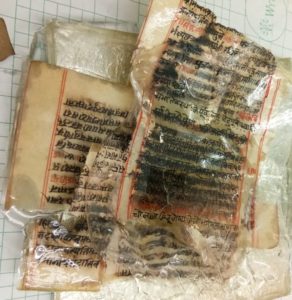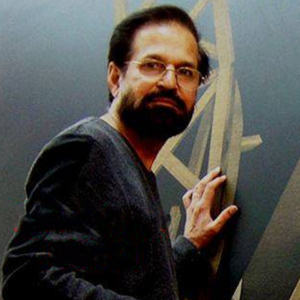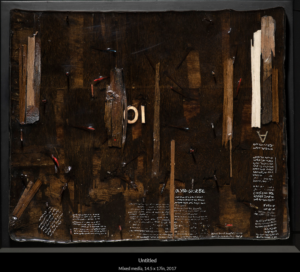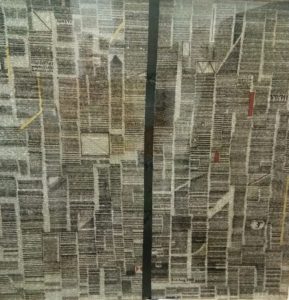Between the layers of time

Saurabh Tankha
Half-an-hour with him and the famous Hindi movie song from Manoj Kumar-starrer Shor, jeevan chalne ka naam, chalte raho subah aur shaam comes to your mind. Rajkavi Inderjit Singh Tulsi may have penned the lyrics for a man wanting to collect money to get his ailing son treated by cycling day-and-night on the big screen, but these words befit artist Rameshwar Broota to the tee in real life.
The life and works of the 1941-born artist, who perhaps would not have even watched this 1972 classic as he “doesn’t have time for anything but art”, are synonymous with another couple of lines from the same song: samay se haath mila mitra, ki ho jaa kiran-kiran mitra… For Broota, like ace filmmaker-lyricist Gulzar, has kept reinventing himself with time. He has moved on with the times, shining with extraordinary skills and doing loads of experimentations in the process.
The soft-spoken artist, who graduated in Fine Arts from the Delhi College of Arts in 1963, is presently serving as the head of department at New Delhi’s Triveni Kala Sangam. “After graduation, I worked as a part-time lecturer in Delhi College of Art, taught art at a government school on Janpath and at Jamia Millia. For this, I had to leave my Rajouri Garden residence at half-past five every morning and change three public transport buses to reach my first destination. And then shuttled between the three during the day,” recalls Broota who is known for his paintings of male bodies, both muscular and emaciated, testament to the passage of time. Over the years, Broota has perfected his unique technique in which he first applies layers of different coloured paints on the surface and then meticulously scrapes away the upper layers of the painting with a sharp knife, to literally unearth his luminous images.
So, the moment Triveni management offered him the job of a teacher, Broota replied in affirmative. This was in the year 1967. “I couldn’t have asked for more as I had to stay at one place the entire day as the classes were held in the mornings and evenings for two hours every alternate day. So I left everything and moved in and have stayed on,” he adds. And what’s more? He was even given an accommodation at Triveni too. “Earlier, they had four quarters where the new block now stands. When American architect Joseph Allen Stein redesigned Triveni, in the mid-1970s, residences were made on the top floor,” he shares.
So, Broota leaves the art classes around nine every night, only to return an hour later after his dinner and daily capsule of news on television. “Then I stay here till midnight or may be less or more, depending on my mood,” he says. “During my third year of days at College of Arts, I often came here to grab a bite and wished, on seeing the creative atmosphere, that one day I should be working here. And it happened,” he puts in.
How has been the more than five-decade long journey with Triveni been? “Very fruitful. Very satisfying. Very creative,” says Broota who still feels that both his elder brothers were better artists than him. “Just that our father didn’t let them pursue art. I was luckier as they both managed to convince him to let me study art,” he says, adding that he wanted to join the defence forces.
Today, at 77, Broota still has enthusiasm which can put a teenager to shame. His studio at Triveni has a blank black canvas waiting for the artist to shower his creative genius onto it as well as a few glass-like objects, in various shapes and sizes, literally strewn all over. Not-to-be-missed is the huge Mac about which the artist says is his creative associate. “I love experimenting with my mediums. I bought a computer in the 90s along with a scanner and a printer. It helped me upload a photo and see which colour scheme would suit which painting. Over time, I kept upgrading it as per my requirements till I bought this,” says Broota who has also made three 5-6 minute films, The Body, Biography of Life and Shabash Bete after learning the nuances of filmmaking including editing.
One is intrigued by the glass-like objects kept all arpund on his differet tables. Broota says, “Once I used a paper shredder and I liked the shape of the paper which came out of it. I thought why not use this in glass or something so that it looks good. But then where to get a liquid which solidifies, I thought. Products made of glass are manufactured in factories in large quantities so this process was ruled out as was making moulds as it would have been difficult to handle for someone my age. So, I kept googling till I bumped into a chemical called epoxy resin which comes in liquid form. The best part is that it remains transparent and crystal clear after solidifying. So, I put one layer of epoxy resin and then placed some papers. Then poured another layer. This I kept doing layer over layer… Similarly, I wrote on one of the layers and then added another layer over it… Some of the creations, which will fall in the category of sculptures, have up to 30 or more layers,” shares Broota.

As I get ready to leave, I could not help but click a few of the works of Broota, much before he puts it out at an exhibition for the world to see later this year.






2 Comments
Wow👌👌Quite inspiring write up on a great super senior artist.. Salutes to him👍👍
Are these d pics of epoxy sculptures mentioned in d article?
yes